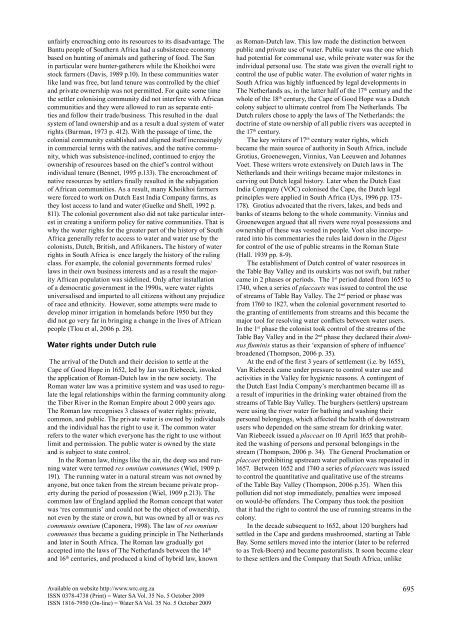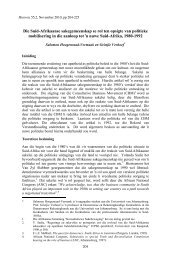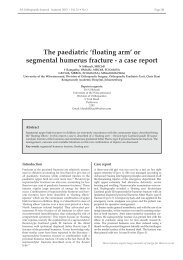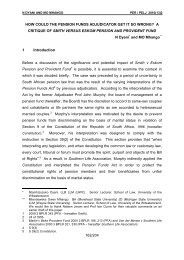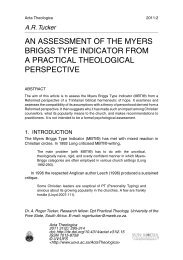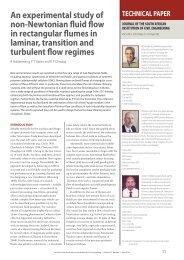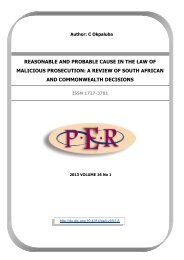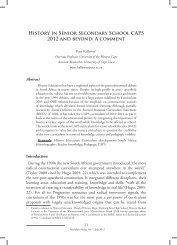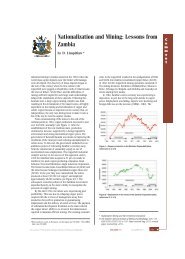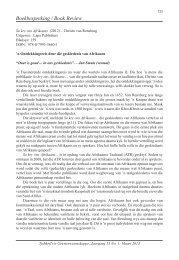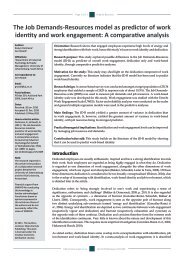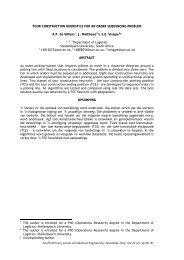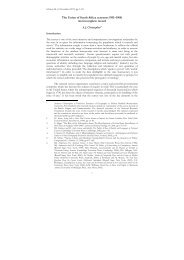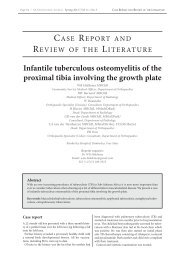A detailed analysis of evolution of water rights in South Africa: An ...
A detailed analysis of evolution of water rights in South Africa: An ...
A detailed analysis of evolution of water rights in South Africa: An ...
You also want an ePaper? Increase the reach of your titles
YUMPU automatically turns print PDFs into web optimized ePapers that Google loves.
unfairly encroach<strong>in</strong>g onto its resources to its disadvantage. The<br />
Bantu people <strong>of</strong> <strong>South</strong>ern <strong>Africa</strong> had a subsistence economy<br />
based on hunt<strong>in</strong>g <strong>of</strong> animals and gather<strong>in</strong>g <strong>of</strong> food. The San<br />
<strong>in</strong> particular were hunter-gatherers while the Khoikhoi were<br />
stock farmers (Davis, 1989 p.10). In these communities <strong>water</strong><br />
like land was free, but land tenure was controlled by the chief<br />
and private ownership was not permitted. For quite some time<br />
the settler colonis<strong>in</strong>g community did not <strong>in</strong>terfere with <strong>Africa</strong>n<br />
communities and they were allowed to run as separate entities<br />
and follow their trade/bus<strong>in</strong>ess. This resulted <strong>in</strong> the dual<br />
system <strong>of</strong> land ownership and as a result a dual system <strong>of</strong> <strong>water</strong><br />
<strong>rights</strong> (Burman, 1973 p. 412). With the passage <strong>of</strong> time, the<br />
colonial community established and aligned itself <strong>in</strong>creas<strong>in</strong>gly<br />
<strong>in</strong> commercial terms with the natives, and the native community,<br />
which was subsistence-<strong>in</strong>cl<strong>in</strong>ed, cont<strong>in</strong>ued to enjoy the<br />
ownership <strong>of</strong> resources based on the chief’s control without<br />
<strong>in</strong>dividual tenure (Bennet, 1995 p.133). The encroachment <strong>of</strong><br />
native resources by settlers f<strong>in</strong>ally resulted <strong>in</strong> the subjugation<br />
<strong>of</strong> <strong>Africa</strong>n communities. As a result, many Khoikhoi farmers<br />
were forced to work on Dutch East India Company farms, as<br />
they lost access to land and <strong>water</strong> (Guelke and Shell, 1992 p.<br />
811). The colonial government also did not take particular <strong>in</strong>terest<br />
<strong>in</strong> creat<strong>in</strong>g a uniform policy for native communities. That is<br />
why the <strong>water</strong> <strong>rights</strong> for the greater part <strong>of</strong> the history <strong>of</strong> <strong>South</strong><br />
<strong>Africa</strong> generally refer to access to <strong>water</strong> and <strong>water</strong> use by the<br />
colonists, Dutch, British, and Afrikaners. The history <strong>of</strong> <strong>water</strong><br />
<strong>rights</strong> <strong>in</strong> <strong>South</strong> <strong>Africa</strong> is ence largely the history <strong>of</strong> the rul<strong>in</strong>g<br />
class. For example, the colonial governments formed rules/<br />
laws <strong>in</strong> their own bus<strong>in</strong>ess <strong>in</strong>terests and as a result the majority<br />
<strong>Africa</strong>n population was sidel<strong>in</strong>ed. Only after <strong>in</strong>stallation<br />
<strong>of</strong> a democratic government <strong>in</strong> the 1990s, were <strong>water</strong> <strong>rights</strong><br />
universalised and imparted to all citizens without any prejudice<br />
<strong>of</strong> race and ethnicity. However, some attempts were made to<br />
develop m<strong>in</strong>or irrigation <strong>in</strong> homelands before 1950 but they<br />
did not go very far <strong>in</strong> br<strong>in</strong>g<strong>in</strong>g a change <strong>in</strong> the lives <strong>of</strong> <strong>Africa</strong>n<br />
people (Tlou et al, 2006 p. 28).<br />
Water <strong>rights</strong> under Dutch rule<br />
The arrival <strong>of</strong> the Dutch and their decision to settle at the<br />
Cape <strong>of</strong> Good Hope <strong>in</strong> 1652, led by Jan van Riebeeck, <strong>in</strong>voked<br />
the application <strong>of</strong> Roman-Dutch law <strong>in</strong> the new society. The<br />
Roman <strong>water</strong> law was a primitive system and was used to regulate<br />
the legal relationships with<strong>in</strong> the farm<strong>in</strong>g community along<br />
the Tiber River <strong>in</strong> the Roman Empire about 2 000 years ago.<br />
The Roman law recognises 3 classes <strong>of</strong> <strong>water</strong> <strong>rights</strong>: private,<br />
common, and public. The private <strong>water</strong> is owned by <strong>in</strong>dividuals<br />
and the <strong>in</strong>dividual has the right to use it. The common <strong>water</strong><br />
refers to the <strong>water</strong> which everyone has the right to use without<br />
limit and permission. The public <strong>water</strong> is owned by the state<br />
and is subject to state control.<br />
In the Roman law, th<strong>in</strong>gs like the air, the deep sea and runn<strong>in</strong>g<br />
<strong>water</strong> were termed res omnium communes (Wiel, 1909 p.<br />
191). The runn<strong>in</strong>g <strong>water</strong> <strong>in</strong> a natural stream was not owned by<br />
anyone, but once taken from the stream became private property<br />
dur<strong>in</strong>g the period <strong>of</strong> possession (Wiel, 1909 p.213). The<br />
common law <strong>of</strong> England applied the Roman concept that <strong>water</strong><br />
was ‘res communis’ and could not be the object <strong>of</strong> ownership,<br />
not even by the state or crown, but was owned by all or was res<br />
communis omnium (Caponera, 1998). The law <strong>of</strong> res omnium<br />
communes thus became a guid<strong>in</strong>g pr<strong>in</strong>ciple <strong>in</strong> The Netherlands<br />
and later <strong>in</strong> <strong>South</strong> <strong>Africa</strong>. The Roman law gradually got<br />
accepted <strong>in</strong>to the laws <strong>of</strong> The Netherlands between the 14 th<br />
and 16 th centuries, and produced a k<strong>in</strong>d <strong>of</strong> hybrid law, known<br />
as Roman-Dutch law. This law made the dist<strong>in</strong>ction between<br />
public and private use <strong>of</strong> <strong>water</strong>. Public <strong>water</strong> was the one which<br />
had potential for communal use, while private <strong>water</strong> was for the<br />
<strong>in</strong>dividual personal use. The state was given the overall right to<br />
control the use <strong>of</strong> public <strong>water</strong>. The <strong>evolution</strong> <strong>of</strong> <strong>water</strong> <strong>rights</strong> <strong>in</strong><br />
<strong>South</strong> <strong>Africa</strong> was highly <strong>in</strong>fluenced by legal developments <strong>in</strong><br />
The Netherlands as, <strong>in</strong> the latter half <strong>of</strong> the 17 th century and the<br />
whole <strong>of</strong> the 18 th century, the Cape <strong>of</strong> Good Hope was a Dutch<br />
colony subject to ultimate control from The Netherlands. The<br />
Dutch rulers chose to apply the laws <strong>of</strong> The Netherlands: the<br />
doctr<strong>in</strong>e <strong>of</strong> state ownership <strong>of</strong> all public rivers was accepted <strong>in</strong><br />
the 17 th century.<br />
The key writers <strong>of</strong> 17 th century <strong>water</strong> <strong>rights</strong>, which<br />
became the ma<strong>in</strong> source <strong>of</strong> authority <strong>in</strong> <strong>South</strong> <strong>Africa</strong>, <strong>in</strong>clude<br />
Grotius, Groenewegen, V<strong>in</strong>nius, Van Leeuwen and Johannes<br />
Voet. These writers wrote extensively on Dutch laws <strong>in</strong> The<br />
Netherlands and their writ<strong>in</strong>gs became major milestones <strong>in</strong><br />
carv<strong>in</strong>g out Dutch legal history. Later when the Dutch East<br />
India Company (VOC) colonised the Cape, the Dutch legal<br />
pr<strong>in</strong>ciples were applied <strong>in</strong> <strong>South</strong> <strong>Africa</strong> (Uys, 1996 pp. 175-<br />
178). Grotius advocated that the rivers, lakes, and beds and<br />
banks <strong>of</strong> steams belong to the whole community. V<strong>in</strong>nius and<br />
Groenewegen argued that all rivers were royal possessions and<br />
ownership <strong>of</strong> these was vested <strong>in</strong> people. Voet also <strong>in</strong>corporated<br />
<strong>in</strong>to his commentaries the rules laid down <strong>in</strong> the Digest<br />
for control <strong>of</strong> the use <strong>of</strong> public streams <strong>in</strong> the Roman State<br />
(Hall. 1939 pp. 8-9).<br />
The establishment <strong>of</strong> Dutch control <strong>of</strong> <strong>water</strong> resources <strong>in</strong><br />
the Table Bay Valley and its outskirts was not swift, but rather<br />
came <strong>in</strong> 2 phases or periods. The 1 st period dated from 1655 to<br />
1740, when a series <strong>of</strong> placcaets was issued to control the use<br />
<strong>of</strong> streams <strong>of</strong> Table Bay Valley. The 2 nd period or phase was<br />
from 1760 to 1827, when the colonial government resorted to<br />
the grant<strong>in</strong>g <strong>of</strong> entitlements from streams and this became the<br />
major tool for resolv<strong>in</strong>g <strong>water</strong> conflicts between <strong>water</strong> users.<br />
In the 1 st phase the colonist took control <strong>of</strong> the streams <strong>of</strong> the<br />
Table Bay Valley and <strong>in</strong> the 2 nd phase they declared their dom<strong>in</strong>us<br />
flum<strong>in</strong>is status as their ‘expansion <strong>of</strong> sphere <strong>of</strong> <strong>in</strong>fluence’<br />
broadened (Thompson, 2006 p. 35).<br />
At the end <strong>of</strong> the first 3 years <strong>of</strong> settlement (i.e. by 1655),<br />
Van Riebeeck came under pressure to control <strong>water</strong> use and<br />
activities <strong>in</strong> the Valley for hygienic reasons. A cont<strong>in</strong>gent <strong>of</strong><br />
the Dutch East India Company’s merchantmen became ill as<br />
a result <strong>of</strong> impurities <strong>in</strong> the dr<strong>in</strong>k<strong>in</strong>g <strong>water</strong> obta<strong>in</strong>ed from the<br />
streams <strong>of</strong> Table Bay Valley. The burghers (settlers) upstream<br />
were us<strong>in</strong>g the river <strong>water</strong> for bath<strong>in</strong>g and wash<strong>in</strong>g their<br />
personal belong<strong>in</strong>gs, which affected the health <strong>of</strong> downstream<br />
users who depended on the same stream for dr<strong>in</strong>k<strong>in</strong>g <strong>water</strong>.<br />
Van Riebeeck issued a placcaet on 10 April 1655 that prohibited<br />
the wash<strong>in</strong>g <strong>of</strong> persons and personal belong<strong>in</strong>gs <strong>in</strong> the<br />
stream (Thompson, 2006 p. 34). The General Proclamation or<br />
placcaet prohibit<strong>in</strong>g upstream <strong>water</strong> pollution was repeated <strong>in</strong><br />
1657. Between 1652 and 1740 a series <strong>of</strong> placcaets was issued<br />
to control the quantitative and qualitative use <strong>of</strong> the streams<br />
<strong>of</strong> the Table Bay Valley (Thompson, 2006 p.35). When this<br />
pollution did not stop immediately, penalties were imposed<br />
on would-be <strong>of</strong>fenders. The Company thus took the position<br />
that it had the right to control the use <strong>of</strong> runn<strong>in</strong>g streams <strong>in</strong> the<br />
colony.<br />
In the decade subsequent to 1652, about 120 burghers had<br />
settled <strong>in</strong> the Cape and gardens mushroomed, start<strong>in</strong>g at Table<br />
Bay. Some settlers moved <strong>in</strong>to the <strong>in</strong>terior (later to be referred<br />
to as Trek-Boers) and became pastoralists. It soon became clear<br />
to these settlers and the Company that <strong>South</strong> <strong>Africa</strong>, unlike<br />
Available on website http://www.wrc.org.za<br />
ISSN 0378-4738 (Pr<strong>in</strong>t) = Water SA Vol. 35 No. 5 October 2009<br />
ISSN 1816-7950 (On-l<strong>in</strong>e) = Water SA Vol. 35 No. 5 October 2009<br />
695


